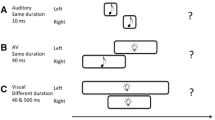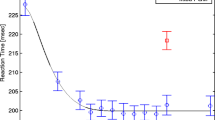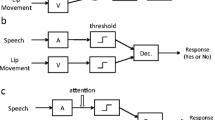Summary
Reaction times and the relative latency evaluated by the temporal-order-judgment method for two stimuli of different modalities (visual and auditory) were measured. The difference between reaction times for visual and auditory stimuli was about 40 ms. The relative latency was slightly shorter, however; in conflict with Rutschmann and Link's (1964) previous result, the auditory stimulus must be delayed to be perceived simultaneously with the visual one.
Similar content being viewed by others
References
Allan, L. G. (1975), The relationship between judgments of successiveness and judgment of order.Perception & Psychophysics,18, 29–36.
Allan, L.G., & Kristofferson, A. B. (1974). Successiveness discrimination: Two models.Perception & Psychophysics, 15, 37–46.
Ayer, M., Brunk, H. D., Ewing, G. M., Reid, W. T., & Silverman, E. (1955). An empirical distribution function for sampling with incomplete information.Annals of Mathematical Statistics, 26, 641–647.
Barr, M. (1983). A comparison of reaction-time and temporal-order-judgement estimates of latency to sinusoidal gratings.Perception, 12, A7.
Diaconic, P., & Efron, B. (1983). Computer-intensive methods in statistics.Scientific American, 248, 116–130.
Didner, R., & Sperling, G. (1980). Perceptual delay: A consequence of metacontrast and apparent motion.Journal of Experimental Psychology: Human Performance and Perception, 6, 235–243.
Efron, B., & Gong, G. (1983). A leisurely look at the bootstrap, the jacknife, and cross-validation.The American Statistician, 37, 36–48.
Epstein, B., & Churchman, C. W. (1944). On the statistics of sensitivity data.Annals of Mathematical Statistics, 15, 90–96.
Hirsh, I. J., & Sherrick, C. E. (1961). Perceived order in different sense modalities.Journal of Experimental Psychology, 62, 423–432.
Jaśkowski, P. (1987). The effect of retinal location on simple motor reaction time and perceived simultaneity.Perception, 16, 208.
Kristofferson, A. B. (1967a). Attention and psychophysical time.Acta Psychologica, 27, 93–100.
Kristofferson, A. B. (1967b). Successiveness discrimination as a two-state quantal process.Science, 158, 1337–1339.
Levitt, H. (1971). Transformed up-down methods in psychoacoustics.Journal of the Acoustical Society of America, 49, 467–477.
Menendez, A., & Lit, A. (1983). Effects of test-flash and steady background luminance on simple visual reaction time (RT) and perceived simultaneity (PS).Investigative Ophthalmology and Visual Science, 24, 5.
Roufs, J. A. J. (1974). Dynamic properties of vision. V: Perception lag and reaction time in relation to flicker and flash threshold.Vision Research, 14, 853–869.
Rutschmann, J., & Link, R. (1964). Perception of temporal order of stimuli differing in sense mode and simple reaction time.Perceptual & Motor Skills, 18, 345–352.
Spearman, C. (1908). The method of “right and wrong cases” (“constant stimuli”) without Gauss's formulae.British Journal of Psychology, 2, 227–242.
Sternberg, S., & Knoll, R. L. (1973). The perception of temporal order: Fundamental issues and a general model. In S. Komblum (Ed.).Attention and performance, 4. New York: Academic Press, pp. 629–685.
Sternberg, S., Knoll, R. L., & Zukofsky, P. (1982). Timing by skilled musicians. In D. Deutsch (Ed.),The psychology of music. New York: Academic Press, pp. 181–239.
Ulrich, R. (1987). Threshold models of temporal-order judgments evaluated by ternary response task.Perception & Psychophysics, 42, 224–239.
Ulrich, R., Stapf, K. H. (1984). A double response paradigm to study stimulus intensity effects upon the motor system in simple reaction time experiments.Perception & Psychophysics, 36, 545–558.
Author information
Authors and Affiliations
Rights and permissions
About this article
Cite this article
Jaśkowski, P., Jaroszyk, F. & Hojan-Jezierska, D. Temporal-order judgments and reaction time for stimuli of different modalities. Psychol. Res 52, 35–38 (1990). https://doi.org/10.1007/BF00867209
Received:
Accepted:
Issue Date:
DOI: https://doi.org/10.1007/BF00867209




